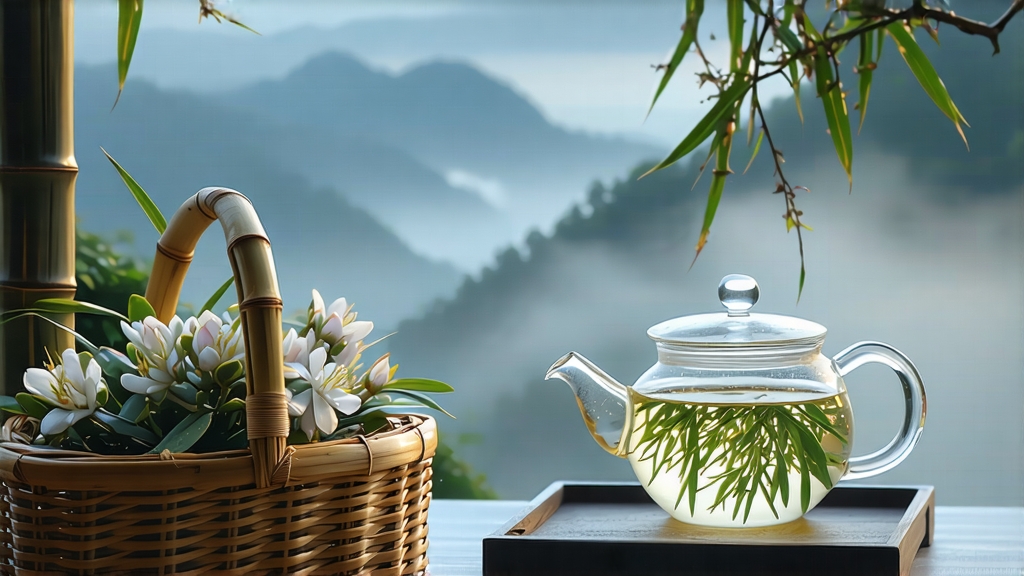
Among the six great families of Chinese tea, white tea is the least theatrical yet the most elusive; it is oxidised only by air, time, and the patience of its maker. Within this minimalist lineage, one cultivar stands as the purest expression of leaf and season—White Hair Silver Needle, known in Chinese as Bai Hao Yin Zhen. If green tea is the exuberant youth and pu-erh the venerable elder, Silver Needle is the moonlit poet who speaks in whispers, leaving the listener forever unsure where fragrance ends and memory begins.
Origin and legend
The recorded history of Silver Needle begins in the 1790s among the granite peaks of northern Fujian, where the Xiao Bai (Small White) and Da Bai (Big White) tea trees first caught the attention of tea merchants seeking tribute teas for the Jiaqing Emperor. Local lore, however, antedates imperial edicts. Farmers tell of a midnight meteor that streaked across the sky above Fuding County, its silver tail scattering stardust on the mountain tea bushes; the next morning the buds appeared cloaked in an unearthly down. Whether meteor or mutation, the cultivar’s tiny white hairs—technically trichomes that protect the bud from early-spring chill—became the visual signature that still decides price and prestige.
Geography and microclimate
Authentic Silver Needle is produced in only two protected counties: Fuding and Zhenghe, both hugging the East China Sea. The region’s red lateritic soil is laced with quartz and mildly acidic; nights are cool and fog-laden, while afternoons bring a warm sea breeze. This oscillation slows photosynthesis, forcing the plant to stockpile amino acids—especially L-theanine—yielding the tea’s hallmark brothy sweetness. No other location, even when the same Da Bai cultivar is transplanted, has managed to replicate the precise balance of oceanic air and mountain mist that condenses on the bud’s silvery cloak.
Plucking etiquette
The harvest window is brutally short: three, at most five, days in late March when the buds reach 2.5–3 cm but have not yet unfurled into a second leaf. Experienced pickers work backwards, starting at dawn when dew still glues the bud’s protective sheath, because friction after sunrise can shear off the precious hairs. Each pluck is a single “dragon’s tooth” lifted upward with the nail, never pinched, to prevent bruising. A full kilogram of finished tea demands roughly thirty thousand buds—an entire day’s labour for five skilled workers.
Crafting without craft
White tea’s minimalism is often mistaken for ease; in truth, restraint is the hardest virtuosity. Once baskets arrive at the cottage factory, the buds are spread no thicker than two fingers on bamboo trays woven from river reeds. For the next 36–48 hours they simply sleep, exhaling moisture while enzymes nibble at polyphenols. The only intervention is the shifting of trays from sun-lit corridors to shaded alcoves as the sun arcs, a choreography guided by fingertip assessments of ambient humidity. When the bud’s moisture drops to 8–10 %, a final charcoal bake at 40 °C locks in stability without adding roast flavour. No rolling, no pan-firing, no kneading—just withering and waiting. The result is a leaf structure so intact that electron micrographs still show erect stomata, as though the bud might reanimate at the next rainfall.
Grading and authenticity
International markets often dilute Silver Needle with later flushes or neighbouring cultivars. Authentic spring Silver Needle can be identified by three visual cues: uniform needle length (rarely exceeding 3 cm), a downy sheath that stands perpendicular to the bud (flattened hairs suggest machine drying), and a faint pistachio-green hue at the bud’s base where chlorophyll has not fully blanched. When rubbed gently, genuine buds emit a cool, bean-sprout aroma; counterfeits smell grassy or, worse, faintly metallic from accelerated oven drying.
Water and fire: brewing philosophy
Silver Needle is introverted; it reveals itself only when treated like a shy guest—warmly, but without effusion. Begin with soft water whose mineral content lies below 80 ppm; high calcium dulls the tea’s orchid top notes. Heat the water to 80 °C, just when the first columns of steam begin to ribbon upward but before the kettle sings. Use glass or porcelain; yixing clay, beloved for darker teas,